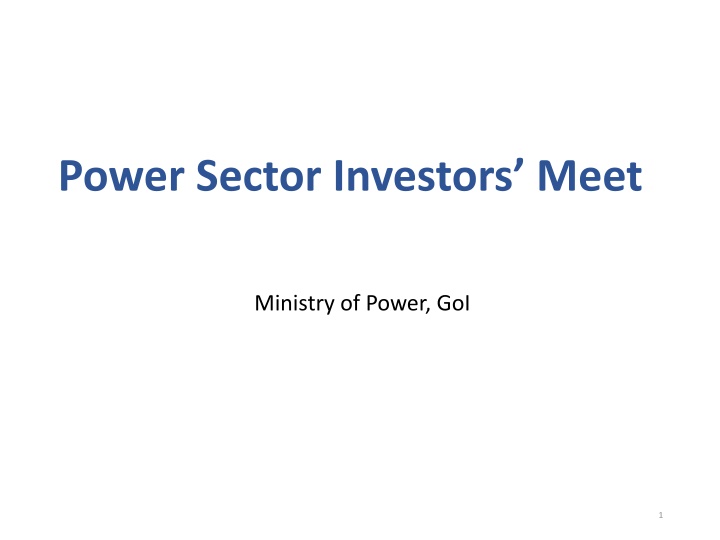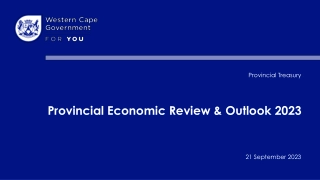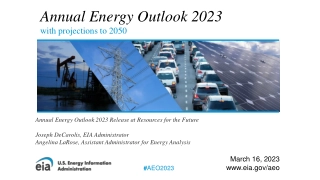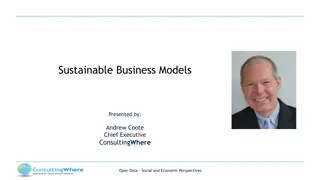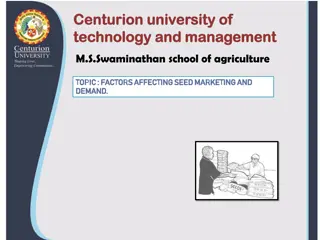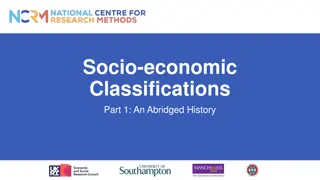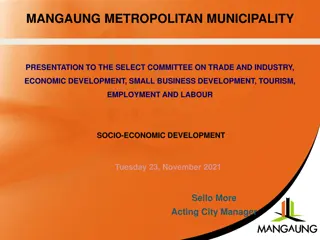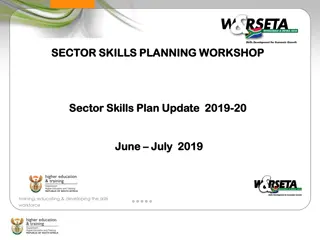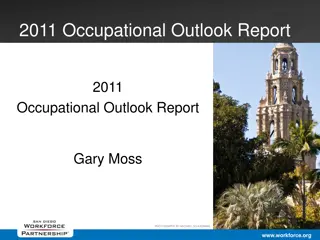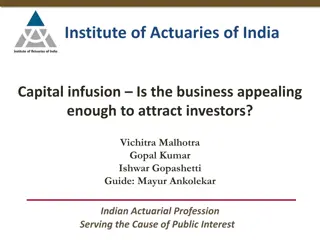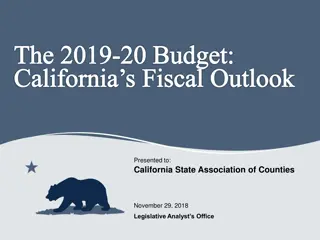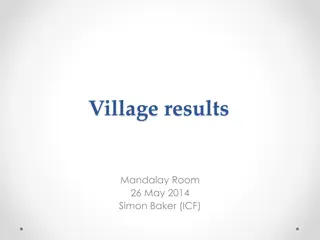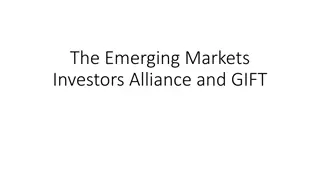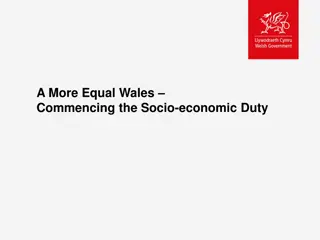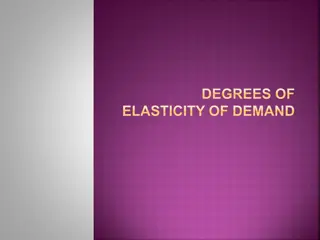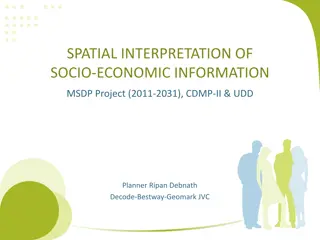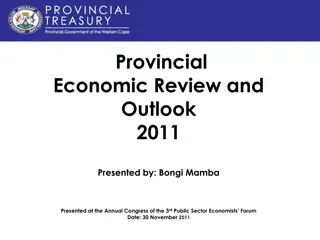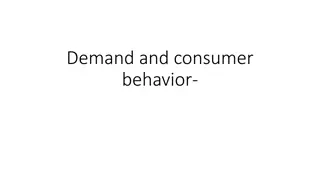Power Sector Investors Meet Highlights: Socio-Economic Trends, Demand Outlook, and Key Interventions
The presentation outlines the rising trends in electric mobility, rapid urbanization's impact on energy demand, and the adoption of cleaner energy sources. It discusses the growth drivers, myths, key issues, and interventions by the Government of India in the power sector. The power sector is facilitating social and economic transformation by enhancing per capita consumption, making utilities efficient, and ensuring 24x7 affordable and reliable power supply. Positive electricity demand outlook highlights the expected growth rate and potential in different regions.
Download Presentation

Please find below an Image/Link to download the presentation.
The content on the website is provided AS IS for your information and personal use only. It may not be sold, licensed, or shared on other websites without obtaining consent from the author.If you encounter any issues during the download, it is possible that the publisher has removed the file from their server.
You are allowed to download the files provided on this website for personal or commercial use, subject to the condition that they are used lawfully. All files are the property of their respective owners.
The content on the website is provided AS IS for your information and personal use only. It may not be sold, licensed, or shared on other websites without obtaining consent from the author.
E N D
Presentation Transcript
Power Sector Investors Meet Ministry of Power, GoI 1
Outline of the presentation Socio Economic Trends and Power Sector Electricity Demand Outlook Drivers of Growth Myths Prevailing in the Sector Key Issues and GoI Interventions 2
Socio Economic Trends Rising trend of Electric Mobility 1 5 3 2 4 Rapid Urbanization to drive Energy Demand Better Utility- Consumer Engagement Adoption of Cleaner Energy Sources Adoption of electricity for cooking ` Increased Consumption will boost Manufacturing for appliances. Higher demand for products & services e.g. Smart Meters. Accelerated demand for RES technologies and services. E-mobility to create additional demand Rural sector consumers to increasingly adopt electricity as primary fuel for cooking. Rising trend of EV adoption to boost demand for EV Subsystems. Estimated No of Smart/Prepaid meters required ~70 Million, immediately New Business segments to help integrate VRE penetration in grid. India: Appliance energy consumption projection 482 TWh/yr Major contribution towards base demand. 380 TWh/yr Source: CEA, 2017 EV Ancillary Services such as battery swapping, recycling to receive major boost. Energy efficiency adoption to create new segments. Estimated* annual Energy Supply (BU) by RES 383 BU 2021 2026 Estimated Capacity requirement for HH cooking @20% adoption ~50 GW. Estimated Investment in EE, 2015-2040 $ 832 Bn. Source: World Bank, 2008 124 BU Estimated No of EVs by 2030 ~261 Million Strong demand to propel energy intensive industries e.g. steel and cement 2022 2017 Source: IEA 2015 Source: MoP New PPP ventures with Utilities Source: MoP *At Avg. PLF of 25% Source: NITI Ayog 2017, (Transformative Scenario) The largest contribution to demand growth (2017-2040)- almost 30% - comes from India, whose share of global energy use rises to 11% by 2040 (World Energy Demand 2040: 3305Mtoe) 3 -IEA World Energy Outlook, 2017
Power Sector is enabling Social and Economic Transformation. Increasing Per Capita Consumption 818 kWh (FY 11) to 1122 kWh (FY 17) Source: CEA 2017 Connecting the last household Requirement of additional 28,000 MW / 80,000 MUs per annum Source: SAUBHAGYA portal Making Utilities Efficient and Viable 25% reduction in DISCOMs financial losses in last 1 year Source: UDAY Portal 24X7 Affordable and Reliable Power Growth in energy billed by ~9% in FY17 against ~6% in FY16 Source: CEA, UDAY Portal Increasing transparency & Customer Inclusion Portals/APPs launched along with a National Power Portal 4
Positive Electricity Demand Outlook c Present Power Demand growth CAGR: 5% Expected Power Demand growth CAGR (FY 17 FY 22: 6% Significant demand Potential: Similar Socio-Economic Conditions but different Annual per capita Consumption 1,566 1600 240 North Africa* 1687 226 220 1400 Latin America* 2059 3051 200 East Asia * 1,160 1200 1,108 180 1,049 World* 160 967 3126 960 160 1000 909 All India 1122 153 140 148 NE Region 392 800 136 135 120 130 Eastern Region 694 600 100 Southern Region 1432 2011-12 2012-13 2013-14 2014-15 2015-16 2016-17 2021-22 Western Region 1533 EnergyDemand ('000 MU) Peak Demand ('000 MW) Northern Region 1003 Source: CEA and 19th EPS Source: WB analysis and CEA 0 500 1000 1500 2000 2500 3000 Electrification and Last Mile Connectivity 24X7 Power for All Key Drivers of Demand Demand Growth Reliability of Supply Key Drivers of Hours of Supply Electrification of Transport 5
Drivers of Growth 1 Increase in the Supply Base 4 24X7 Improvement in Governance & Transparency Affordable and Reliable Power 2 Expansion of Transmission Network Increased Investment Opportunities 5 Adoption of Emerging Trends & Technology 3 Distribution Reforms & System Strengthening 7
Increase in Supply Base Increase in Supply Base Coal Sector Transformation: Shortage to Surplus to Superior Coal Mines (Special Provisions) Act, 2015: SHAKTI: Power Sector Linkage Policy Transparent Allocation of coal blocks to through E Auction Coal Linkage through transparent auctions COAL SECTOR TRANSFORMATION Linkage policy Non Regulated sector: Transparent Allocation through E-Auction to steel and cement sectors. Coal production by CPSEs: Sustained increase in production has led to fuel reliability and lesser imports 2016-17 659 MT Annual Domestic Coal Production Trend 2015-16 639 MT 2014-15 609 MT 2013-14 566 MT 2012-13 556 MT 2011-12 540 MT 8 Source: CEA
Increase in Supply Base Increase in Supply Base Opportunities in Generation: Catering future Base Load Renewable Sources 180 173 19th EPS Predicts a sustained growth in Energy and Peak Demand 160 RE Installed Capacity 149 140 CAGR (FY 10- FY 18) : 22% Envisaged CAGR (FY 18- FY 22) :22% 3500 500 124 3049 120 450 3000 448 100 100 2531 400 2500 78 80 370 2047 350 2000 57 60 1566 300 299 1500 40 1160 250 16 226 1000 20 200 0 162 500 150 2009-10 2016-17 2017-18 2018-19 2019-20 2020-21 2021-22 Source: Draft, NEP 2016 0 100 2016-17 2021-22 2026-27 2031-32 2036-37 Investment Line-up in next 5-10 Years Energy Requirement (BU) Peak Load (GW) Source: 19th EPS 266 GW Addition Sustained Growth in Demand is inclusive of increasing Adoption of Energy Efficiency Measure 19th EPS is rather conservative compared with other credible sources. USD 310- 350 Bn. 293 Global Firms Enhancing RE Capacity 9 Source: IBEF
Increase in Supply Base Opportunities in Generation: Catering beyond Base Load Expected India Duck Curve with 20,000 MW Solar Generation Envisaged RE Capacity Entails higher Grid Penetration of Variable Sources 200 50% 173 180 45% 160 149 40% 140 124 37% 35% 120 34% 100 100 30% 30% 78 80 26% 25% 57 60 20% 22% 40 18% 15% 20 0 10% 2016-17* 2017-18 2018-19 2019-20 2020-21 2021-22 Installed Capacity RES (GW) RES as % of Total Source: Draft, NEP 2016 Source: NLDC Smart Grid Technologies Peak Load Management Human Error Avoidance Ancillary Services Frequency Management Voltage Management RE Grid Integration: Opportunities Capacity Market Storage Devices Demand Supply Balance Excess RE Generation 10
Expansion of Transmission Network Transmission: Growing in cohorts with Generation Target vs Actual Transmission Capacity Addition ( 000 ckm) Target vs Actual Transformation Capacity Addition ( 000 MVA) 18% 17% 30 28 26 90 16% 16% 82 24 25 13% 23 80 22 14% 21 70 20 20 64 63 19 20 12% 19 57 60 17 17 17 51 10% 10% 15 45 50 15 35 40 8% 32 10 10 30 10 6% 6% 5% 20 11 4% 9 4% 10 5 2% 0% 0 FY '13 FY '14 FY '15 FY '16 FY '17 0 0% FY '11 FY '12 FY '13 FY '14 FY '15 FY '16 FY '17 Q2 '18 Target (MVA) Achievement (MVA) Source: CEA Target Achievement % Uncleared Vol Source: CEA 3.2 Lakh Crore Investment Opportunity in Transmission Sector FY 18- 22 Projects Awarded Till Date through Tariff Based Competitive Bidding (TBCB) 39 Project Value awarded in FY 2016 21,000 Cr Source: CRISIL Source: KPMG analysis Intra state TBCB to fuel the next wave of Investments in Transmission 11
Distribution Reforms and System Strengthening Electrification and Last Mile Connectivity: Outlay INR 42,561 Crores (DDUGJY) Segregation of Agriculture feeder Outlay: 15,190 Crore Universal Metering Outlay: 3,859Crore Access to Rural Households Outlay: 10,246 Crore System Strengthening Outlay: 9,997 Crore Non Paying Consumers Weak T&D Infra Household Electrification Status Village Electrification Status DDUGJY Un electrified Initially 18,452 Un electrified Initially 4,37,46,279 Un -Connected Households Electrified Till Now 15,981 Electrified Till Now 2,79,18,695 Intensive electrification to connect Villages Outlay: 1,333 Crore Remaining 1,370 Remaining 4,07,92,171 DDUGJY DDUGJY 12
Distribution Reforms and System Strengthening Electrification and Last Mile Connectivity Last mile connectivity to all un- electrified households in rural areas and poor households in urban areas Outlay : Rs. 16,320 Crore SAUBHAGYA About 4 crore households to be electrified by March 2019 Source: MoP Demand Potential to be realized through Electrification of Households 18.05 18 ~4 Crore HHs to be Electrified 16 14.05 14 ~28 GW 12 Demand Implication 10 Annual Demand to be realized by connecting all Households 8 6 Source: MoP 4 2 0 Total Scope Electrified Households in Crores 13
Distribution Reforms and System Strengthening DISCOM Transformation and Strengthening IPDS UDAY 24X7 Reliable & Affordable Supply Commercially Viable Discoms An integrated scheme for urban areas with outlay Rs 27,052 Crores, targeting IT Enablement (Quality and Reliability) System Strengthening Eliminate stress of Banking Sector from DISCOM exposure Achievements under IPDS Key improvement under UDAY IT enablement completed in 1367 towns; fresh sanctions for 1932 towns amounting to Rs 985 Crores. Target FY18 Parameters FY16 FY17 ACS-ARR Gap (Rs. / kWh) Old System strengthening projects completed in 970 towns; fresh sanctions for 3616 towns. 0.60 0.42 0.20 AT&C Losses (%) 21 20 17 Expected to boost industry performance, as IPDS directs interventions in urban areas where most industrial hubs/ centres are located Source: UDAY Portal UDAY Performance UDAY Performance IPDS IPDS 14 Source: MoP
Adoption of Emerging Trends and Technologies Emerging trends: Indicative Opportunity Sizing Decentralized Distributed Generation Ancillary Services Storage Smart Meters Electric Vehicles Increase base- load demand, higher PLF Estimates on EV battery domestic manufacturing under different stages as per report by Niti Ayog Installation of 35 million by end of 2019 (envisaged under UDAY) High significance with increased VRE Total quantum of spinning reserves (primary, secondary and tertiary) is more than 13,500 MW# Currently, tertiary frequency control Going forward, market based ancillary service framework High prospects if initiated at the DISCOM level In Solar Rooftop, 40 GW capacity addition target by 2022 INR 23,450 Cr* central financial assistant for solar roof top installations proposed by MNRE States aggregating capacities and inviting bids Effective channel for renewable peak power EESL procuring 50 lakh smart meters for 2 States through competitive bidding -Battery pack1: Potential: 120 GWh EV Estimates** as per report by Niti Ayog for 2030 - End to end manufacturing2: Potential: 2410 GWh - Business As Usual scenario: 26 million - Transformative scenario: 261 million 15 * Proposed Sristi Scheme, MNRE ; **GDP Growth rate @ 7.4% CAGR; 1Cell import 2Cathodes import, # CERC Estimates for 2015
Likely Investment Potential in Major Segments Investment Potential b/w 2015-2040 as per India Energy Outlook, 2015 Investment (Approx.) Areas In INR In USD Coal Generation INR 22 Lakh Cr $ 354 Billion Nuclear Generation INR 6 Lakh Cr $ 96 Billion Hydro INR 8.8 Lakh Cr $ 141 Billion Renewables INR 38.4 Lakh Cr $ 611 Billion Investment in Transmission & Distribution networks INR 53.2 Lakh Cr $ 845 Billion Source: India Energy Outlook, 2015 On the Distribution side, new trends and emerging areas like Rooftop Solar, EVs, Smart meter, Storage, Ancillary Services etc. to open additional avenues of investment DISCOM turnaround through UDAY to improve the overall performance of power sector, thereby making it more investment friendly 16
Myths prevailing in the Sector UDAY is not Performing Reality: UDAY is a 3 year long programme where performance of the States is contingent to the time spent under UDAY, as different states have joined UDAY at different points in time Early results under UDAY are encouraging, with some distinct benefits on operations. Going forward, improvement in metering to enhance the performance Performance slack in some states may be attributed to interlinked factors like lead time of interventions, data-lag and seasonality of operations etc. UDAY Performance UDAY Performance UDAY is not creating demand Reality: UDAY is a supply side intervention which aims to release the latent demand, that exists in the system due to short supply of power to the consumers. Under UDAY, total energy billed by DISCOMs increased by 9% in FY17* over FY16, indicating a considerable growth in consumption, which in the past years had grown around 5-6%. Growth in Energy Sales Growth in Energy Sales 18
Myths prevailing in the Sector Increase in rural connection under SAUBHAGYA, will result in increase in losses and low cost recovery Reality: SAUBHAGYA scheme would ensure energy access to all households; expected increase in demand of 28 GW. Increase in Demand would lead to lower fixed costs due to higher PLFs. 100% metering is integral to SAUBHAGYA ensuring theft control and revenue recovery Losses are being camouflaged in Agriculture Year wise total Input Energy, total Sales, Agriculture Sales in MUs and year wise Percentage Agriculture Sales 823935 790207 719222 652233 621141 570537 26.6% 26.6% 26.0% 173988 165355 148480 2013-14 2014-15 2015-16 Source: CEA Total Energy Input (MU) Total Sales (MU) Agriculture Sale (MU) Above details are for 14 states contributing 95% of the Agriculture sales. Pecentage of Agricultural sales have remained largely in the same range from FY14 to FY16. Therefore, there is no tell-tale sign of losses being loaded on the Agricultural category. 19
Key Issues and Ongoing GoI Interventions 20
Key Issues and Ongoing GoI Interventions Stressed Projects (coal based) in Power Sector Current Status Major reasons for stress Action taken for resolution of Stress Shakti Scheme: To provide assured supply of coal through allocation and auctioning Pilot scheme- to procure 2500 MW Amendment in Mega Power Policy: -Competitive bidding for future PPAs, -Remove liquidity crunch with developers -Ensuring project competitiveness Non-availability of fuel Commissioned capacity: 24,405 MW No PPA tie-ups Delayed payments by Discoms Under construction capacity: 15,725 MW Inability- infuse equity, service debt Aggressive tariffs by bidders in PPAs Regulatory/ contractual disputes Steps by Lenders Total stressed capacity: 40,130 MW Legal Issues- auctioned coal mines - Joint lender forum, Flexible restructuring (5/25); invocation of SDR; Scheme for Sustainable Structuring of Stressed Assets (S4A) Other financial issues like non- compliance of Joint Lender Forum (JLF) decisions, RBI restrictions on funding of cost overrun, etc. Comprises 34* projects - NCLT through IBC Act, 2016, SARFAESI, DRT. 21 * As per list provided by Dept of Financial Services
Key Issues and Ongoing GoI Interventions Revival of Hydro Why hydro needs revival NEW HYDRO POLICY 2017 The following have been proposed: Revival of stalled projects, improving investor confidence Declaring all hydropower (irrespective of size) as Renewable Energy. Tariff affordability and push for PPAs through Hydropower Purchase Obligation Providing hydropower purchase obligations apart from solar RPO. Hydropower qualities critical for future- Flexibility, Fastest ramping, Voltage regulation, Reactive power absorption, Black start. Financial support in the form of interest subvention/ equivalent support. Financial moderation hydropower projects. support for storage/ flood Meeting peaking power and grid integration requirement for 175 GW RE. Providing level playing field with Renewables Bringing discipline- Project Construction/ Mgmt. Water Storage- Flood moderation/Strategic Needs 22
Annexures 23
UDAY 24
UDAY Performance UDAY has a clear impact towards improvement in operational efficiency and decline in overall losses Comparative Progress of H1 Achievement FY 2016-17 S. No. Base year Data (31.03.2016) Parameter Unit Achievement H1 FY17 Achievement H1 FY18 AT&C Losses 1 (In %) 21 20 24 23 ACS-ARR GAP 2 (Rs./unit) 0.60 0.42 0.46 0.37 Energy Billed 3 MUs 75,77,88 3,76,287 4,21,192 69,31,52* Increase: 9.3% *Data as per PFC report Back to Myths UDAY snapshot Back to Myths UDAY snapshot 25 Note: In all slides base year data of AT&C and GAP is as per PFC report (calculated as per revised methodology). Rest Data as per UDAY portal
UDAY Performance Operational Achievements in Key UDAY parameters till H1,FY18 Progress during UDAY period Overall Progress Overall achieveme nt till June'17 Operational efficiency indicators Base year Data (FY16) Achievement (April 16 June 17) in %age Overall %age achieveme nt Target (April 16 June 17) Achievemen t (April 16 - June 17) Overall No. to be achieved Urban Feeder Metering (Nos) 100% 99% 40,302 2,027 5,006 45,555 45,308 Rural Feeder Metering (Nos) 100% 96% 86,404 10,801 13,285 1,03,681 99,689 Domestic connections (In Lakhs) 86% 80% 1,364 136 116 1,867 1,480 UJALA LED-bulb (In Lakhs) 100% 100% 637 1,147 1,679 2,146 2,315 *Note: States have filled data till Q1 FY18 Back to Myths UDAY snapshot Back to Myths UDAY snapshot 26
UDAY Performance Energy Billed by DISCOMs (MUs) in UDAY States increased at a relatively higher rate 9% in FY17 against 6% in FY16 Quarterly Performance Annual Performance MUs 757,788 MUs 201,903 9% 10% 693,152 MUs 6% MUs 183,638 653,433 MUs FY15 FY16 FY17 Q1FY17 Q1FY18 Back to Myths UDAY snapshot Source: PFC Report FY 2015-16 Back to Myths UDAY snapshot 27
UDAY Performance A total of 19 States have increased their tariff either in FY 16 or FY17. Tariff hikes have resulted in an additional revenue of Rs. 10,009 Cr. in FY 16 and Rs. 20,427 Cr. in FY17 State wise Tariff Hike FY 2016-17 FY 2015-16 12% 14% 10% 9% UDAY: Pre and Post 8% 8% 8% 4% 4% 4% 4% 4% Impact of tariff hike on Total Income (%) 2% Period 0% 0% 0% Himachal Pr J&K Jharkhand Manipur Puducherry Telangana Sikkim Mizoram Pre-UDAY FY 16 2.31% FY 2017-18 FY 2015-16 20% Post-UDAY FY 17 4.35% 9% 9% 8% 8% 8% 6% 6% 5% 5% 5% 1% 0% 0% 0% 0% 0% 0% Andhra Pr. Assam Bihar Kerala Karnataka Madhya Pr. Punjab Uttarakhand Meghalaya Back to Myths UDAY snapshot Back to Myths UDAY snapshot 28
IPDS 29
Integrated Power Development Scheme Rs 27,052 Cr sanctioned under IPDS - Rs 26,236 Cr System strengthening + Rs 985 Cr IT + Rs 69 Cr Smart meters for Old Kashi Pilot System Strengthening projects for 3616 towns Rs. 26,236 Cr sanctioned including Rs. 16,314 Cr as GOI Grant, Rs. 4817 Cr released Quantum of work envisaged for System Strengthening in Urban sector :- Back 30 Back
DDUGJY 31
Deen Dayal Upadhyay Gramin Jyoti Yojana (DDUGJY) Rs.42561 Crore sanctioned including GoI Grant of Rs.32607 Crore. Component wise details are as follows: Electrification of UE Villages through Grid Metering System Strengthening Feeder Separation Rs. 2,667 Crore Rs. 3,859 Crore Rs. 9997.45 Crore Rs. 15190.89 Crore % Physical Progress Achieved w.r.t. awarded Quantity 11% 10% 27% 24% 20% Sanctioned Quantity Awarded Quantity Completion as on 18.01.2018 Milestone Name Unit No. MVA No. MVA CKm 1,825 1,591 168 12,998 11,730 1,124 2,145 1,537 414 8,675 7,775 1,890 123,653 159,981 31,794 New 33/11 KV Substation Augmentation LT Line 11 KV Line (Excluding feeder segregation) 33&66 KV Line Feeder Segregation (excluding 11 KV New Lines) Distribution Transformers Lines CKm 111,412 98,252 14,986 15% CKm 25,183 23,486 1,953 8% Feeder Segregation CKm 159,571 147,703 11,679 8% Distribution Transformers No. MVA Nos Nos Nos 385,638 360,849 31,108 12,686 12,598 2,172 15,160,243 10,371,200 3,242,446 377,120 331,082 32,665 29,336 14,817 3,822 9% 17% 31% 10% 26% Consumer DTR 11 KV Feeder Energy Meters 32
